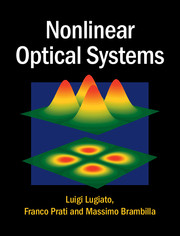Book contents
- Frontmatter
- Dedication
- Contents
- Preface
- Part I Models, propagation, stationary phenomena
- Part II Dynamical Phenomena, Instabilities, Chaos
- Part III Transverse optical patterns
- Appendix A The Routh–Hurwitz stability criterion
- Appendix B Calculation of the oscillatory instability boundary
- Appendix C Coefficients of the characteristic equation (20.20)
- Appendix D Derivation of equations (20.27) and (20.28)
- Appendix E Coefficients of equations (20.60) and (20.61)
- Appendix F The exact boundary of the Risken–Nummedal–Graham–Haken instability
- Appendix G Nonlinear analysis of the roll solution
- References
- Index
Part III - Transverse optical patterns
Published online by Cambridge University Press: 05 March 2015
- Frontmatter
- Dedication
- Contents
- Preface
- Part I Models, propagation, stationary phenomena
- Part II Dynamical Phenomena, Instabilities, Chaos
- Part III Transverse optical patterns
- Appendix A The Routh–Hurwitz stability criterion
- Appendix B Calculation of the oscillatory instability boundary
- Appendix C Coefficients of the characteristic equation (20.20)
- Appendix D Derivation of equations (20.27) and (20.28)
- Appendix E Coefficients of equations (20.60) and (20.61)
- Appendix F The exact boundary of the Risken–Nummedal–Graham–Haken instability
- Appendix G Nonlinear analysis of the roll solution
- References
- Index
Summary
The field of optical pattern formation concerns the spatial and spatio-temporal phenomena that arise in the structure of the electromagnetic field in the planes orthogonal with respect to the direction of propagation. Most theoretical treatments of the interaction between matter and radiation introduce the plane-wave approximation, i.e. assume that the electric field is uniform in each transverse plane. In this way, the time-evolution equations depend only on one spatial variable, i.e. the longitudinal variable z which corresponds to the direction of propagation. By dropping the plane-wave approximation, one opens the door to the fascinating world of pattern formation. In the paraxial approximation this corresponds to keeping, in the time-evolution equation of the electric field, the term with the transverse Laplacian which describes diffraction of radiation; this term couples the different points of the transverse (x, y) plane, as is necessary for pattern formation. With the exception of the discussion of spatial Kerr solitons in Section 7.3, in the analysis of Maxwell-Bloch equations, or of other nonlinear optical models, in Parts I and II of this book we have always adopted the plane-wave approximation, whereas now in Part III we study the transverse effects.
The interaction of light with linear inhomogeneous media can give rise to spatial structures of interesting and remarkable complexity. However, the field of optical pattern formation concerns mainly the interaction with nonlinear media, where the phenomena emerge spontaneously as a consequence of an instability; another name that is commonly used to designate optical pattern formation is “transverse nonlinear optics” or “optical morphogenesis”. Historically, the interest in optical pattern formation emerged as a natural evolution of the previous development of the field of optical instabilities and chaos, when the main attention shifted gradually from purely temporal effects to spatio-temporal phenomena. The evolution was made possible also by the spectacular increase of the computational capabilities of available computers.
- Type
- Chapter
- Information
- Nonlinear Optical Systems , pp. 317 - 322Publisher: Cambridge University PressPrint publication year: 2015



